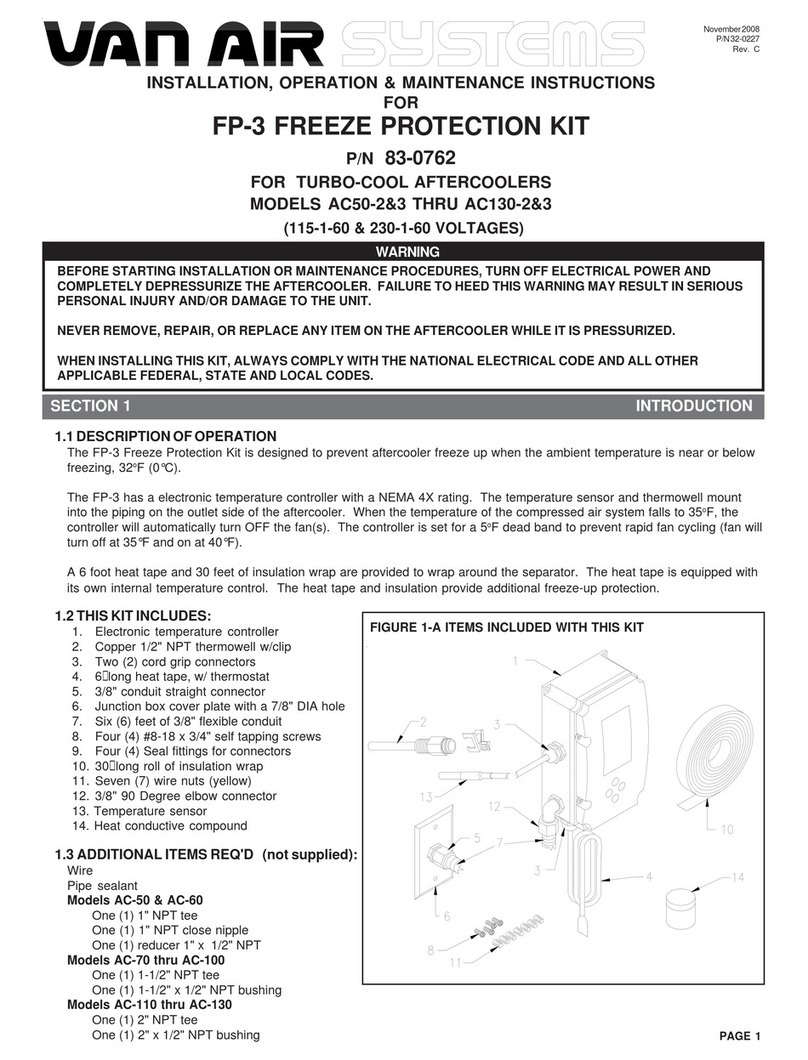
PAGE 4 PRINTED IN THE U.S.A.
INSTALLING THE DRYER SECTION 4
4.1 LOCATION
WARNING
DO NOT INSTALL THIS DRYER IN AN ENVIRONMENT OF
CORROSIVE CHEMICALS, EXPLOSIVE GASSES, POISONOUS
GASSES, OR SATURATED STEAM HEAT.
Locate dryer in a protected, well vented area where ambient
temperatures are between 40oF and 120oF. If this dryer must be
installed where ambient temperatures are below 40oF, insulation and
heat tracing must be properly installed on the inlet piping, purge exhaust
line and the desiccant towers to prevent freezing of the equipment.
Position the dryer in the upright position on a solid, level, vibration free
surface capable of supporting the dryer’s weight. Allow sufficient
clearance over and around the dryer. Refer to SECTION 3.2 for dryer
dimensions.
The dryer should not be located in extremely dirty areas where airborne
contaminants can accumulate on the dryer. If this cannot be prevented,
the dryer should be cleaned periodically.
4.2 PIPING AND ANCILLARY EQUIPMENT
IMPORTANT
Make sure that the inlet air piping is connected to the bottom and the
outlet air piping is connected to the top of the dryer.
Make sure that the inlet and outlet piping to and from the dryer is
properly supported. Excessive stress may cause damage and/or
dryer malfunction.
Remove protective caps or covers from all valves before installing this
dryer.
If this dryer is to be installed into an existing piping system, clean the
existing inlet piping to remove all accumulated dirt, pipe scale, etc.,
before connecting the dryer. Make sure that the inlet and outlet shutoff
valves are tightly closed before connecting to the existing piping system.
When installing the piping and any additional components, make sure
that adequate pipe supports are used. Excessive stress on the dryer
and components may cause damage or premature failure. Use either
overhead or stiff-leg type supports.
Make sure that the piping is correctly connected to the dryer. The inlet
is the bottom connection and the outlet is the top connection.
Reference SECTION 3.2 for dryer dimensions and connection
locations.
Once the location has been determined, place the dryer into position.
Reference SECTION 1 for handling instructions.
4.2-1 BYPASS PIPING (optional)
The installation of bypass piping is not required, but will allow the
dryer and filter(s) to be taken off stream without interrupting the air
system.
In Figure 4A, a recommended bypass piping layout and additional
components are shown. Basic bypass piping should include an inlet
isolation valve, a bypass valve, and an outlet isolation valve. The
isolation and bypass valves must be bubble-tight.
4.2-2 FILTERS CAUTION
A PROPERLY RATED COALESCING PREFILTER MUST BE
INSTALLED BEFORE THE DRYER TO REMOVE LUBRICATING
OILS, DUST AND PIPE SCALE CONTAMINATION. FAILURE TO
USE A PREFILTER WILL RESULT IN DAMAGE TO THE DRYER
AND VOIDS THE WARRANTY.
Make sure that the elements are installed in all filter housings
prior to start up.
4.3 REMOTE PURGE EXHAUST PIPING
To reduce the noise during purging and tower depressurization, this
dryer was supplied with a muffler for installation on the purge exhaust
valve. If the sound or humidity discharged from this dryer is unaccept-
able, the purge of this dryer can be piped remotely away.
IMPORTANT
Make sure that the piping is as short as possible and does not
create back pressure on the dryer. To prevent liquid accumula-
tion in the piping and purge valve, the piping must be at the
same level or lower than the purge valve.
The purge line must be vented to atmospheric pressure. If the
ambient temperature at the venting end of the piping is subject
to temperatures below 32oF, freeze protection must be installed.
The purge valve has threaded pipe connections. Reference Section
3.2 for location. Use adequate pipe supports on the piping to prevent
stress on the valve.
The distance will determine the size of piping that is recommended.
For distances of 10 feet or less, use piping of the same size as the
purge valve. For distances up to 20 feet, use piping one size larger
than the purge valve.
A coalescing prefilter must be installed before the dryer to remove
lubricating oils, dust and pipe scale contamination. It is
recommended that a high efficiency coalescing filter with an
automatic drain or electric drain valve be installed. The filter should
be equipped with a pressure differential indicator to monitor the
condition of the element.
A particulate afterfilter should be installed downstream of the dryer.
The afterfilter will remove any desiccant dust. The afterfilter should
be equipped with a pressure differential indicator to monitor the
condition of the element.
Make sure that the filters are properly installed according to the
instructions provided with them.
4.5 INSTALLING THE PURGE MUFFLER
To reduce the sound level during purge and tower depressurization,
this dryer was supplied with a muffler for installation on the purge
exhaust valve. For muffler location Reference SECTION 3.2.
4.4 INSTALLING PRESSURE RELIEF VALVES
CAUTION
THESE VESSELS MUST BE PROTECTED BY PRESSURE RELIEF
VALVES. Refer to OSHA 1910.169 Par. b, Sub. Par (3) and ASME
Boiler and Pressure Vessel Code, Section VIII, Division 1, UG-125
through UG-136. Also check government regulations, i.e., state
and local codes.
Relief valve connection ports were NOT provided on this dryer. It is
recommended that relief valves be installed to comply with all
applicable codes. The relief valves should be full flow type, rated for
the dryer operating conditions. For recommended location see Figure
4A.
The muffler was shipped separately. It should NOT be installed until
the dryer has been operated for several hours. From desiccant
installation, some dust may be present in the desiccant towers.
Operating the dryer with the muffler installed immediately after the
towers have been filled with desiccant or at initial start up may cause
the muffler to clog.
IMPORTANT
The dryer must be operated for several hours without the
muffler after the towers have been filled with desiccant. This
will prevent the muffler from becoming clogged.




























